The AMD Radeon R9 Fury Review, Feat. Sapphire & ASUS
by Ryan Smith on July 10, 2015 9:00 AM ESTCompute
Shifting gears, we have our look at compute performance. As compute performance will be more significantly impacted by the reduction in CUs than most other tests, we’re expecting the performance hit for the R9 Fury relative to the R9 Fury X to be more significant here than under our gaming tests.
Starting us off for our look at compute is LuxMark3.0, the latest version of the official benchmark of LuxRender 2.0. LuxRender’s GPU-accelerated rendering mode is an OpenCL based ray tracer that forms a part of the larger LuxRender suite. Ray tracing has become a stronghold for GPUs in recent years as ray tracing maps well to GPU pipelines, allowing artists to render scenes much more quickly than with CPUs alone.

For LuxMark with the R9 Fury X already holding the top spot, the R9 Fury cards easily take the next two spots. One interesting artifact of this is that the R9 Fury’s advantage over the GTX 980 is actually greater than the R9 Fury X’s over the GTX 980 Ti’s, both on an absolute and relative basis. This despite the fact that the R9 Fury is some 13% slower than its fully enabled sibling.
For our second set of compute benchmarks we have CompuBench 1.5, the successor to CLBenchmark. CompuBench offers a wide array of different practical compute workloads, and we’ve decided to focus on face detection, optical flow modeling, and particle simulations.
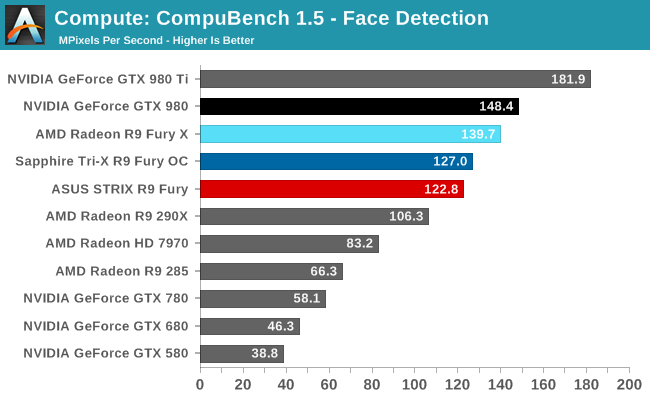
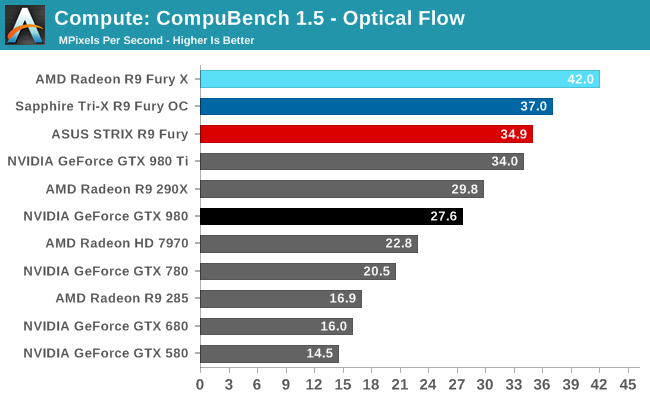

Not unlike LuxMark, tests where the R9 Fury X did well have the R9 Fury doing well too, particularly the optical flow sub-benchmark. The drop-off in that benchmark and face detection is about what we’d expect for losing 1/8th of Fiji’s CUs. On the other hand the particle simulation benchmark is hardly fazed beyond the clockspeed drop, indicating that the bottleneck lies elsewhere.
Our 3rd compute benchmark is Sony Vegas Pro 13, an OpenGL and OpenCL video editing and authoring package. Vegas can use GPUs in a few different ways, the primary uses being to accelerate the video effects and compositing process itself, and in the video encoding step. With video encoding being increasingly offloaded to dedicated DSPs these days we’re focusing on the editing and compositing process, rendering to a low CPU overhead format (XDCAM EX). This specific test comes from Sony, and measures how long it takes to render a video.
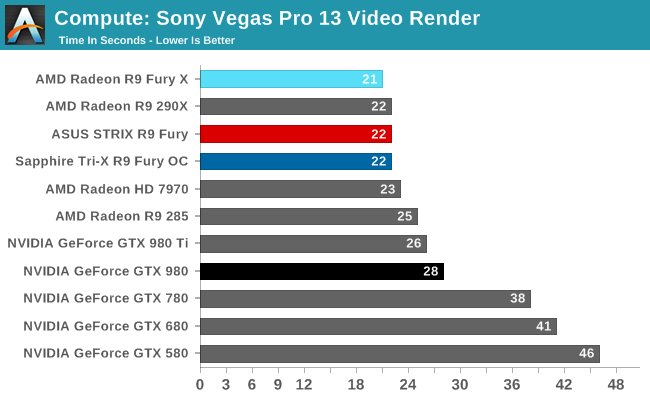
At this point Vegas is becoming increasingly CPU-bound and will be due for replacement. The R9 Fury comes in one second behind the chart-topping R9 Fury X, at 22 seconds.
Moving on, our 4th compute benchmark is FAHBench, the official Folding @ Home benchmark. Folding @ Home is the popular Stanford-backed research and distributed computing initiative that has work distributed to millions of volunteer computers over the internet, each of which is responsible for a tiny slice of a protein folding simulation. FAHBench can test both single precision and double precision floating point performance, with single precision being the most useful metric for most consumer cards due to their low double precision performance. Each precision has two modes, explicit and implicit, the difference being whether water atoms are included in the simulation, which adds quite a bit of work and overhead. This is another OpenCL test, utilizing the OpenCL path for FAHCore 17.
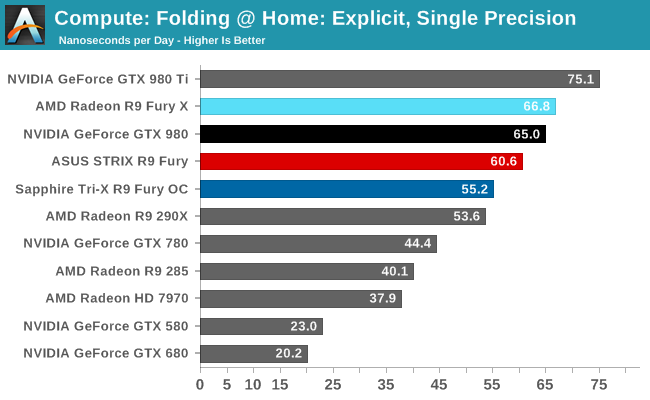
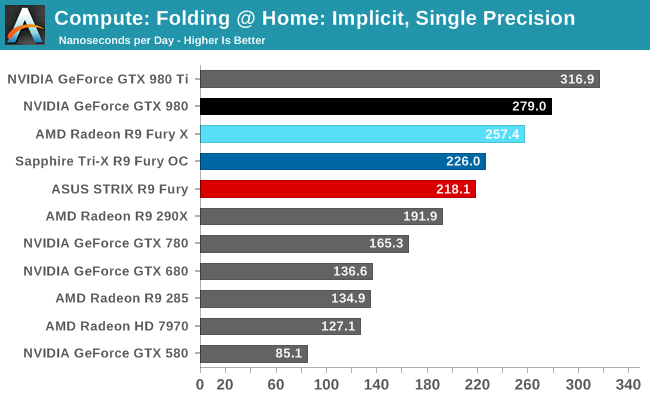

Overall while the R9 Fury doesn’t have to aim quite as high given its weaker GTX 980 competition, FAHBench still stresses the Radeon cards. Under single precision tests the GTX 980 pulls ahead, only surpassed under double precision thanks to NVIDIA’s weaker FP64 performance.
Wrapping things up, our final compute benchmark is an in-house project developed by our very own Dr. Ian Cutress. SystemCompute is our first C++ AMP benchmark, utilizing Microsoft’s simple C++ extensions to allow the easy use of GPU computing in C++ programs. SystemCompute in turn is a collection of benchmarks for several different fundamental compute algorithms, with the final score represented in points. DirectCompute is the compute backend for C++ AMP on Windows, so this forms our other DirectCompute test.
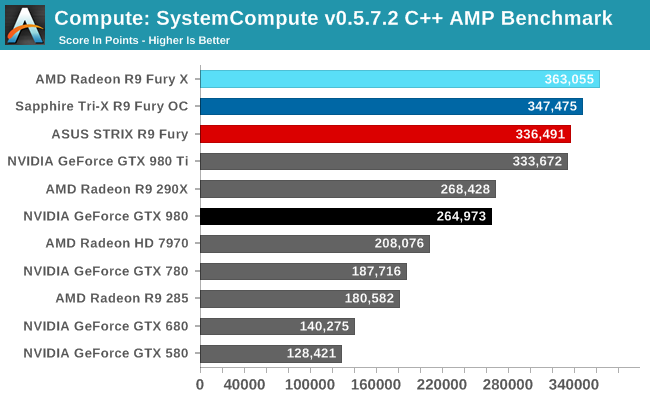
As with our other tests the R9 Fury loses some performance on our C++ AMP benchmark relative to the R9 Fury X, but only around 8%. As a result it’s competitive with the GTX 980 Ti here, blowing well past the GTX 980.










288 Comments
View All Comments
Goty - Friday, July 10, 2015 - link
Can you imagine the hassle upgrades would be with having to deal with two sockets instead of one?Oxford Guy - Saturday, July 11, 2015 - link
Not if the GPU socket standard is universal and backward compatible like PCI-E. It's only if companies get to make incompatible/proprietary sockets that that would be an issue.FlushedBubblyJock - Wednesday, July 15, 2015 - link
Yeah, let's put an additional 300 watts inside a socket laying flat on the motherboard - we can have a huge tube to flow the melting heat outside the case...Yep, that gigantic 8.9B trans core die, slap some pins on it... amd STILL loves pinned sockets...
Yeah, time to move to the motherboard ... ROFLMAO
I just can't believe it ... the smartest people in the world.
ant6n - Saturday, July 11, 2015 - link
I'm definitely interested to see how well these cards would do in a rotated atx Silverstone case. I have one of those, and I'm concerned about the alignment of the fins. You basically want the heat to be able to move up vertically, out the back/top of the card.ajlueke - Friday, July 10, 2015 - link
Priced in between the GTX 980 and the Fury X it is substantially faster than the former, and hardly any slower than the latter. Price performance wise this card is a fantastic option if it can be found around the MSRP, or found at all.FlushedBubblyJock - Wednesday, July 15, 2015 - link
NO, actually if you read, ha ha, and paid attention, lol, 10% more price for only 8% more performance... so it's ratio sucks compared to the NVIDIA GTX 980.Not a good deal, not good price perf compared to NVIDIA.
Thanks for another amd fanboy blowout
Nagorak - Friday, July 10, 2015 - link
One interesting thing from this review is looking at the performance of the older AMD cards. The improvement of the Fury vs the older cards was mentioned by Ryan Smith in the review, noting that performance hasn't improved that much. But there's a lot more to it than that. The relative performance of AMD's cards seem to have moved up a lot compared to their Nvidia competitors.Look at how the 290X stacks up against the GTX 780 in this review. It pretty much just blows it away. The 290X is performing close to the GTX 980 (which explains why the 390X which has faster memory is competitive with it). Meanwhile, the HD 7970 is now stacking up against the GTX 780.
Now, look back at the performance at the time the 290X was released: http://www.anandtech.com/show/7457/the-radeon-r9-2...
It looks like performance on AMD's GCN chips has increased significantly. Meanwhile the GTX 780's performance has at best stayed the same, but actually looks to have decreased.
Anandtech should really do a review of how performance has changed over time on these cards, because it seems the change has been pretty significant.
Nagorak - Friday, July 10, 2015 - link
I don't know, maybe it's just different benchmark settings but the AMD cards look to be a bit more competitive to their counterparts than they were at release.Stuka87 - Friday, July 10, 2015 - link
Its been the case with all GCN cards. AMD continues to make driver optimizations. The 7970 is significantly faster now that it was at launch. Its one advantage of them all sharing a similar architecture.FlushedBubblyJock - Wednesday, July 15, 2015 - link
nvidia CARDS GAIN 10-20% AND MORE over their release drivers... but that all comes faster, on game release days, and without massive breaking of prior fixes, UNLIKE AMD, who takes forever and breaks half of what it prior bandaided, and it takes a year or two or three or even EOL for that fix to come.